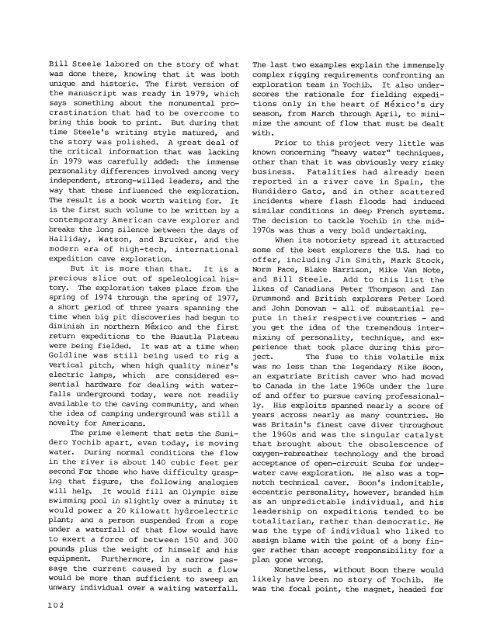8MB PDF - Association for Mexican Cave Studies
8MB PDF - Association for Mexican Cave Studies
8MB PDF - Association for Mexican Cave Studies
- No tags were found...
You also want an ePaper? Increase the reach of your titles
YUMPU automatically turns print PDFs into web optimized ePapers that Google loves.
Bill Steele labored on the story of whatwas done there, knowing that it was bothunique and historic. The first version ofthe manuscript was ready in 1979, whichsays something about the monumental procrastinationthat had to be overcome tobring this book to print. But during thattime Steele's writing style matured, andthe story was polished. A great deal ofthe critical in<strong>for</strong>mation that was lackingin 1979 was carefully added: the immensepersonality differences involved among veryindependent, strong-willed leaders, and theway that these influenced the exploration.The result is a book worth waiting <strong>for</strong>. Itis the first such volume to be written by acontemporary American cave explorer andbreaks the long silence between the days ofHalliday, Watson, and Brucker, and themodern era of high-tech, internationalexpedition cave exploration.But it is more than that. It is aprecious slice out of speleological history.The exploration takes place from thespring of 1974 through the spring of 1977,a short period of three years spanning thetime when big pit discoveries had begun todiminish in northern Mexico and the firstreturn expeditions to the Huautla Plateauwere being fielded. It was at a time whenGoldline was still being used to rig avertical pitch, when high quality miner'selectric lamps, which are considered essentialhardware <strong>for</strong> dealing with waterfallsunderground today, were not readilyavailable to the caving community, and whenthe idea of camping underground was still anovelty <strong>for</strong> Americans.The prime element that sets the SumideroYochib apart, even today, is movingwater. During normal conditions the flowin the river is about 140 cubic feet persecond For those who have difficulty graspingthat figure, the following analogieswill help. It would fill an Olympic sizeswimming pool in slightly over a minute; itwould power a 20 kilowatt hydroelectricplant; and a person suspended from a ropeunder a waterfall of that flow would haveto exert a <strong>for</strong>ce of between 150 and 300pounds plus the weight of himself and hisequipment. Furthermore, in a narrow passagethe current caused by such a flowwould be more than sufficient to sweep anunwary individual over a waiting waterfall.The last two examples explain the immenselycomplex rigging requirements confronting anexploration team in Yochib. It also underscoresthe rationale <strong>for</strong> fielding expeditionsonly in the heart of Mexico's dryseason, from March through April, to minimizethe amount of flow that must be dealtwith.Prior to this project very little wasknown concerning "heavy water" techniques,other than that it was obviously very riskybusiness. Fatalities had already beenreported in a river cave in Spain, theHundidero Gato, and in other scatteredincidents where flash floods had inducedsimilar conditions in deep French systems.The decision to tackle Yochib in the mid1970s was thus a very bold undertaking.When its notoriety spread it attractedsome of the best explorers the U.S. had tooffer, including Jim Smith, Mark Stock,Norm Pace, Blake Harrison, Mike Van Note,and Bill Steele. Add to this list thelikes of Canadians Peter Thompson and IanDrummond and British explorers Peter Lordand John Donovan - all of substantial reputein their respective countries - andyou get the idea of the tremendous intermixingof personality, technique, and experiencethat took place during this project.The fuse to this volatile mixwas no less than the legendary Mike Boon,an expatriate British caver who had movedto Canada in the late 1960s under the lureof and offer to pursue caving professionally.His exploits spanned nearly a score ofyears across nearly as many countries. Hewas Britain's finest cave diver throughoutthe 1960s and was the singular catalystthat brought about the obsolescence ofoxygen-rebreather technology and the broadacceptance of open-circuit Scuba <strong>for</strong> underwatercave exploration. He also was a topnotchtechnical caver. Boon's indomitable,eccentric personality, however, branded himas an unpredictable individual, and hisleadership on expeditions tended to betotalitarian, rather than democratic. Hewas the type of individual who liked toassign blame with the point of a bony fingerrather than accept responsibility <strong>for</strong> aplan gone wrong.Nonetheless, without Boon there wouldlikely have been no story of Yochib. Hewas the focal point, the magnet, headed <strong>for</strong>102
















